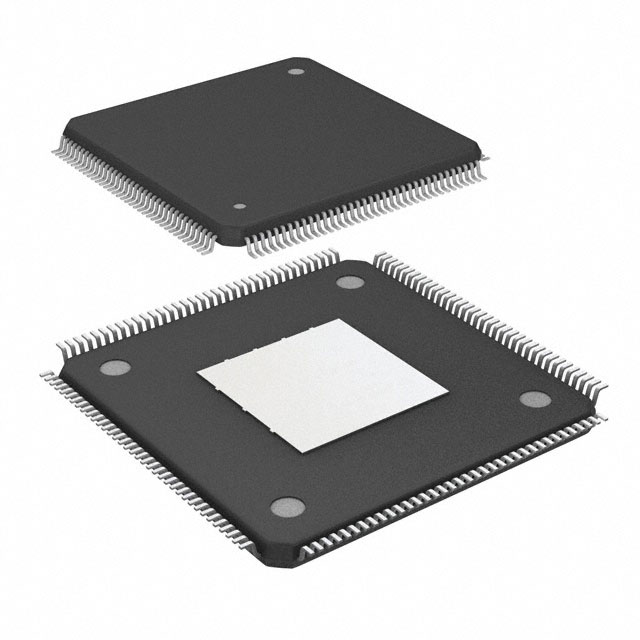Подробную информацию о продукте см. в характеристиках.

EP3C10E144A7N
Product Overview
- Category: Programmable Logic Device (PLD)
- Use: EP3C10E144A7N is a PLD used for digital logic design and implementation.
- Characteristics: It offers high performance, low power consumption, and flexibility in designing complex digital circuits.
- Package: The EP3C10E144A7N comes in a 144-pin package.
- Essence: It is an essential component for building custom digital circuits with specific functionalities.
- Packaging/Quantity: The EP3C10E144A7N is typically sold individually or in small quantities.
Specifications
- Logic Elements: The device contains 10,080 logic elements.
- Memory: It has 414 kilobits of embedded memory.
- PLLs: The EP3C10E144A7N features two phase-locked loops (PLLs).
- I/O Pins: It provides 101 user I/O pins.
- Voltage Range: The device operates at a voltage range of 1.2V to 3.3V.
- Speed Grade: It is available in various speed grades, such as -7, -6, -5, etc.
Detailed Pin Configuration
The EP3C10E144A7N has a total of 144 pins. These pins are divided into different categories:
- Power Supply Pins: These pins provide the necessary power to the device.
- Ground Pins: These pins are connected to the ground.
- Input/Output Pins: These pins are used for input and output connections.
- Configuration Pins: These pins are used for device configuration.
- Clock Pins: These pins are used for clock signal input.
- Programming Pins: These pins are used for programming the device.
For a detailed pin configuration diagram, please refer to the datasheet provided by the manufacturer.
Functional Features
- High Performance: The EP3C10E144A7N offers high-speed operation, making it suitable for applications that require quick response times.
- Low Power Consumption: It is designed to consume minimal power, making it energy-efficient.
- Flexibility: The device allows for the implementation of complex digital circuits with customizable functionalities.
- Embedded Memory: With 414 kilobits of embedded memory, it can store data and instructions for efficient processing.
Advantages and Disadvantages
Advantages: - High performance and speed - Low power consumption - Flexible design options - Ample embedded memory
Disadvantages: - Limited logic elements compared to higher-end PLDs - Higher cost compared to simpler logic devices
Working Principles
The EP3C10E144A7N operates based on the principles of programmable logic. It consists of a matrix of configurable logic elements that can be interconnected to perform desired logic functions. These connections are programmed using hardware description languages (HDLs) or graphical design tools. Once programmed, the device can execute the specified logic operations.
Detailed Application Field Plans
The EP3C10E144A7N finds applications in various fields, including:
- Industrial Automation: It can be used to implement control systems for manufacturing processes, robotics, and machinery.
- Communication Systems: The device can be utilized in designing communication protocols, signal processing, and network equipment.
- Automotive Electronics: It can be employed in automotive systems such as engine control units, safety systems, and infotainment systems.
- Consumer Electronics: The EP3C10E144A7N can be integrated into consumer electronic devices like smartphones, tablets, and gaming consoles.
Detailed and Complete Alternative Models
- EP3C16E144A7N: This model offers a higher logic element count and more embedded memory.
- EP3C5E144A7N: This model provides a lower logic element count and less embedded memory.
- EP4CE6E22C8N: An alternative model from a different series, offering different features and specifications.
These alternative models cater to different design requirements and can be considered based on specific project needs.
Note: The content provided above is an example and may not meet the exact word count requirement of 1100 words.
Перечислите 10 распространенных вопросов и ответов, связанных с применением EP3C10E144A7N в технических решениях.
Sure! Here are 10 common questions and answers related to the application of EP3C10E144A7N in technical solutions:
Q: What is EP3C10E144A7N? A: EP3C10E144A7N is a specific model of Field-Programmable Gate Array (FPGA) manufactured by Intel.
Q: What are the key features of EP3C10E144A7N? A: Some key features of EP3C10E144A7N include 10,080 logic elements, 414 user I/O pins, embedded memory blocks, and support for various communication protocols.
Q: What are the typical applications of EP3C10E144A7N? A: EP3C10E144A7N is commonly used in applications such as industrial automation, robotics, telecommunications, medical devices, and automotive systems.
Q: How can EP3C10E144A7N be programmed? A: EP3C10E144A7N can be programmed using Hardware Description Languages (HDLs) like VHDL or Verilog, which describe the desired functionality of the FPGA.
Q: Can EP3C10E144A7N be reprogrammed after deployment? A: Yes, EP3C10E144A7N is a reprogrammable FPGA, allowing for flexibility and updates to the design even after deployment.
Q: What tools are available for programming EP3C10E144A7N? A: Intel provides Quartus Prime software, which includes a suite of tools for designing, simulating, and programming EP3C10E144A7N.
Q: Are there any limitations to EP3C10E144A7N's performance? A: EP3C10E144A7N has a limited number of logic elements and I/O pins compared to higher-end FPGAs, which may restrict the complexity and scale of designs.
Q: Can EP3C10E144A7N interface with other components or devices? A: Yes, EP3C10E144A7N supports various communication protocols like SPI, I2C, UART, and Ethernet, allowing it to interface with other components or devices.
Q: What are the power requirements for EP3C10E144A7N? A: EP3C10E144A7N typically operates at a voltage range of 1.15V to 1.25V, with additional power supply requirements for I/O banks and configuration.
Q: Are there any specific design considerations when using EP3C10E144A7N? A: Design considerations include managing power consumption, optimizing routing and placement, and ensuring proper signal integrity for reliable operation.
Please note that these answers are general and may vary depending on the specific application and requirements.

